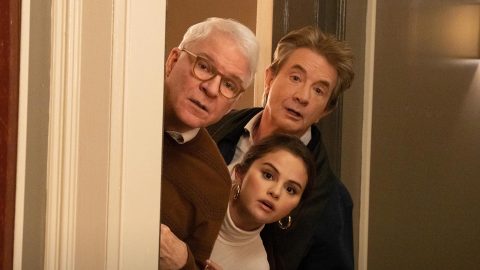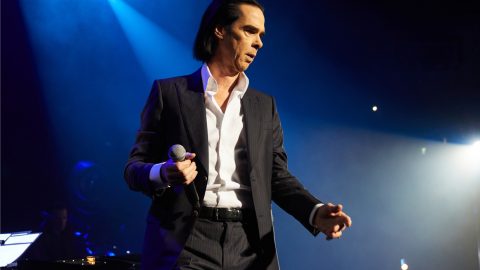
A row of black SUVs roll through the desert dust: The Robots are on the move. Out step Thomas Bangalter and Guy-Manuel de Homem-Christo, helmetless, into the VIP section of the Coachella festival site. Rumours are flying around that Daft Punk are due on stage any moment for a secret set, but instead they and their entourage have travelled to Palm Springs, California to formally unveil ‘Random Access Memories’, the band’s upcoming fourth – and final – studio album. The clip, showcasing a snippet of the feverishly hyped ‘Get Lucky’ and its cast list including Pharrell Williams, Nile Rodgers and more, beams out on the site on the stage’s big screens. The clip is rated E for ‘Everybody Required On The Dancefloor’.
If that sounds ridiculous, it’s because, well, it was. But such was the desire and ambition of the French duo on their first studio album in over eight years. The trailer, which was first shown 10 years ago this week (April 14), followed a run of teasers during ad breaks of Saturday Night Live weeks earlier. Returning to Coachella, where they triumphed with the industry-altering Alive tour in 2006, proved the clapperboard formally calling for action. As Naomi Williams, who worked as the band’s online PR at the time, puts it: “It seemed like they wanted to approach it not as an album campaign but as a blockbuster movie. If you were Daft Punk and could do any campaign you want, why not blow the doors off?”
Of all the records that hit their 10th anniversary this year, ‘Random Access Memories’ is certainly the most curious. It was a time-capsule of a record, one that would attempt to both reflect the era it was made in (the post-millennium arrival of mind-blowing tech into palm-sized devices), and the one it wished it had been a part of (‘70s excess and disco’s heyday). It’s the type of record and rollout that would never exist again, or perhaps never did: ambitious, timeless, overblown, maximalist. Speaking to The Guardian in 2023, Bangalter called it “a record that could not happen before or after” and said the record was a product of the “timing [being] right”. The music, in many ways, would feel secondary to the moment.
I was caught up in the whirlwind. Like many other burgeoning music fans in the late ‘00s, my initial experiences with music discovery were on illegal torrent sites and burnt CDs, navigating dodgy MP3 players and introducing malware to the family computer. I engaged with music on my own selfish terms; my friends and I were told what we were doing was killing the industry when, really, we just wanted to find a way in. Albums simply appeared as files on a screen – I had no idea why music was made and how it would enter our lives.
‘Random Access Memories’ would prove a turning point for me. By 2013, I was heading to festivals, and had started building my own record collection (paid for, honest). This album roll-out would be one I could experience in real-time across the burgeoning social media platforms, of which I was on all of them. I would seek out unofficial remixes of the ‘Get Lucky’ riff being relentlessly looped, and hopelessly mapped out my route from the UK to Wee Waa, the 2,000-strong Australian town where they would throw an unexpected launch party – 10,277 miles away, in case you’re wondering. It was the period where it all started to click.
And the record itself? Well, it’s complicated. At first I was disappointed, as is the way with feverishly-anticipated records – soft-rock, proggy piano ballads weren’t quite my vibe at the time, even if I attempted to convince myself otherwise. This was my ‘Be Here Now’. But it didn’t seem to matter – I had experienced and lived through a seismic album release. In time, I came to appreciate the vision behind the whole ‘Random Access Memories’ experience.

Gabriel Szatan, journalist and author of the upcoming book After Daft: Daft Punk & The Rewiring of 21st Century Culture, remembers 2013 as being an incredible time for music fans. “It felt like every week something big was happening in the music world – there was just an orgy of activity,” he tells NME today.
In the first six months of the year, Justin Timberlake released ‘The 20/20 Experience’, Kanye West began the rollout for ‘Yeezus’, and Vampire Weekend and The National readied modern indie classics in ‘Modern Vampires of The City’ and ‘Trouble Will Find Me’, respectively. David Bowie and My Bloody Valentine made unexpected returns, and in the following months, Disclosure, Lorde, Arctic Monkeys and Beyoncé would all release legacy-defining records.
“The dominance of streaming companies in the coming years changed the arithmetic for how to promote [music],” Szatan says. “This felt like the last days of Rome where everyone was just piling in insane amounts of effort and time and cryptic messages and physical, out-of-house media all to celebrate these albums.”
At the time, Spotify’s user count in 2013 totalled at just 36 million, compared to 489 million users in 2022. In the US, only 42% of adults had multiple social media account profiles, with Facebook being the platform of choice. Short-form video platform Vine, where Daft Punk announced the ‘Random Access Memories’ tracklist, was still in its infancy,
“The battle for eyeballs was no longer just magazine covers, but it was SEO [Search Engine Optimisation], it was in people’s hands and on TV screens,” Szatan says. “It wasn’t just the fact they had billboard and TV ads, but every single thing they did felt bloggable and digestible. Not only did they smash the battle for coverage, but they completely blanketed the infinite scroll at a time when it was in its infancy.”
Kevin EG Perry, who penned NME’s cover story with Daft Punk in 2013, says that the promotion of the record was a deliberate hark back to the past. The band were disillusioned with the EDM boom that was happening around them, even joking to NME that they thought all the big drops and generic beats were written by one man: Eric David Morris. Their response? To blanket Sunset Boulevard in LA with expensive, eye-popping billboards usually reserved for Hollywood hits.
“They felt they were making a classic album that nodded to the glory days of the ‘70s in terms of the sounds they were creating and the live musicians they used, so they wanted the billboards and the NME cover story to go with it,” he says. “It was certainly a transitional time for the music industry, and I think Daft Punk were more aware of that than anyone. I think that’s partly why they set out to make a record that would pay tribute to past masters like Giorgio Moroder while still sounding like the future.”

The week following their Coachella drop, the band released the full version of ‘Get Lucky’ which spent four weeks at the top of the UK Singles Charts, but was kept off the top of the US’ Billboard 200 by another Pharrell-featuring track, Robin Thicke’s controversial ‘Blurred Lines’. ‘Get Lucky’ would become, as Scottish comedian Limmy would promise in his decade-long running joke on Twitter, the “sound of the summer”.
Upon the album’s release, NME scored the album a perfect 10, which Perry says he fought passionately for, even if no-one else on staff had heard the record. It landed alongside an impressive and selective press blitz; The Robots had never been more accessible, as highlighted by the helmet-less, swim shorts-clad, poolside interview they did with NME in Palm Springs. Throughout the campaign, collaborators like Panda Bear, Moroder, DJ Falcon and more queued up to record short-form videos about their role on the record. The hype – and curiosity – on what featured on the record has seldom been replicated.
“The good will was so strong,” Szatan laughs. “Even kids on spring break taking molly [MDMA] were still like, ‘Yes, a nine minute song featuring [The Muppets composer] Paul Williams’, which is hilarious to think that only one artist in the world could pull that off.”
It was an old-school campaign, and with no tour in the pipeline, the record’s release provided a finite full stop. Naomi Williams adds: “I do remember quite a few people saying at the time that this reminded them of the kind of campaign that would have happened in the ‘90s and the so-called ‘golden era’ of the music industry.”
But by the end of the year, the model had been busted open. On December 13, Beyoncé released her fifth, self-titled album with no prior announcement, landing as an iTunes exclusive with no warning: to ‘do a Beyoncé’ was born. In the decade since, Frank Ocean, Kendrick Lamar, Taylor Swift have all released seismic albums in similar fashion. The rise of streaming services aided the long-tail promotion, encouraging post-release marketing plans; the ‘Random Access Memories’ model would appear an antiquity almost immediately.
“They inadvertently began to close the door on quite a short-lived way of marketing music and the digital age,” Szatan says. “Perhaps we’ve lost some amazing campaigns because streaming became all you really need to do. If you’re Drake and you could nail that part of the promotion, and be on the cover of every Spotify playlist, why would you bother with 20 magazine interviews?”
In the months and years that followed, reception to the record cooled and the band faded from public view. Most of the world likely never heard any other song from the record aside ‘Get Lucky’. Following the band’s momentous appearance at The Grammys in 2014 – where they took home Album Of The Year – their work as a duo would be limited to production on songs from The Weeknd and Parcels. They never toured or released music again, and unexpectedly split in February 2021 with an explosive, tongue-in-cheek send-off video.
It’s hard not to feel like ‘Random Access Memories’ was the end of something, even if that moment remains devilishly hard to define. Madonna, Roisin Murphy, Lizzo and Dua Lipa’s forays into disco would prove more impactful in pop music’s wider revival of the genre. The days of Hollywood-sized billboards and TV spots have been replaced by short-form videos of either overbearingly relatable artists spilling every secret to boost streams, or hitting out at their record label for having to do so.
As Szatan puts it, “Daft Punk were a musical unicorn in an age that has very few clear victors”. In hindsight, it seems, ‘Random Access Memories’ was just about as much about the journey than the destination.
“Looking back on records like this, it makes you realise that in 2013 we sat under the night sky and watched a shooting star. And how often do you get that? You can count on two hands over the last 20 years of records and moments like this, and undoubtedly ‘Random Access Memories’ is definitely one of them.”
Daft Punk’s ‘Random Access Memories’ 10th Anniversary Edition will be released May 12 on Columbia Records.
Gabriel Szatan’s ‘After Daft: Daft Punk & The Rewiring of 21st Century Culture’ is released March 2024 and available to pre-order here.
The post Daft Punk’s ‘Random Access Memories’ at 10: how it became the era’s most hyped album appeared first on NME.






